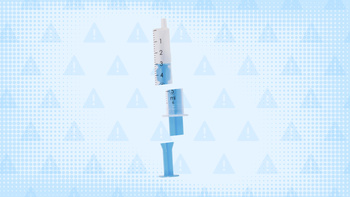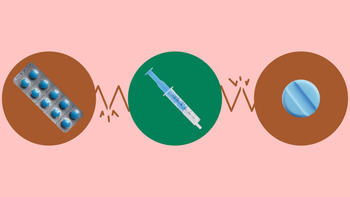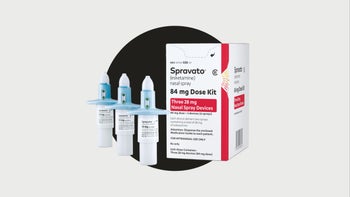
Spravato
Spravato (esketamine) is used for adults with treatment-resistant depression (TRD). It also treats adults who have depression with suicidal thoughts or behavior. As an NMDA antagonist, it works in the brain to regulate mood. Spravato (esketamine) is a nasal spray that you must use at a treatment center. At first, you take it twice a week for 4 weeks. After that, people with treatment-resistant depression can take it once a week. Side effects include feeling sleepy and dissociated (disconnected from your thoughts or feelings). Side effects can be serious, so you must join the Spravato REMS program to get treatment.

What is Spravato (esketamine)?
What is Spravato (esketamine) used for?
Treatment-resistant depression (TRD) in adults
Major depressive disorder in adults who have suicidal ideation or behavior
How Spravato (esketamine) works
Spravato (esketamine) is an N-methyl-D-aspartate (NMDA) receptor antagonist. It's not exactly known how the medication works to help with depression. But researchers think it works in the brain to balance the chemicals and signaling pathways that regulate mood.
Drug Facts
More on Spravato (esketamine) essentials

What are the risks and warnings for Spravato (esketamine)?
Spravato (esketamine) can cause some serious health issues. This risk may be even higher for certain groups. If this worries you, talk to your doctor or pharmacist about other options.

Sleepiness, slowed breathing, and dissociation
Risk factors: Psychosis | Drinking alcohol while taking Spravato (esketamine) | Taking other medications that cause sleepiness or slow your body down
Spravato (esketamine) can make you very sleepy, which can make it hard for you to focus, think, or react. The medication can also slow your breathing down a lot, which can be dangerous. These side effects can be worse if you drink alcohol or take other medications that make you sleepy or slow your body down.
In addition, Spravato (esketamine) can cause dissociation. This is when you feel disconnected with your thoughts, feelings, and sense of self. You can also feel unaware of your surroundings or lose your sense of time.
To monitor for these risks, your care team will keep an eye on you at the treatment center for at least 2 hours after each Spravato (esketamine) dose. They'll make sure it's safe for you to leave. Have someone pick you up from the treatment center. You shouldn't drive or do anything requiring concentration until the next day after a good night's rest.

Potential for misuse and dependence
Risk factors: History of substance or alcohol use disorder | History of dependence
Spravato (esketamine) is a schedule 3 controlled substance because it can be misused or cause dependence. These risks can be serious and even life-threatening. Your prescriber will check in with your often to make sure you're using the medication safely.

Must enroll in the Spravato REMS program to get treated
Spravato (esketamine) has a risk of serious side effects. It can make you sleepy, feel dissociated from reality, and have very slowed breathing. This medication also has a potential risk for misuse. These risks can be very dangerous.
Because of these risks, the FDA requires Spravato (esketamine) to be given through the Spravato REMS program. You, your prescriber, and the pharmacy that provides Spravato (esketamine) must all be signed up for this Risk Evaluation and Mitigation Strategy program. This helps make sure the medication is used as safely as possible.

Suicidal thoughts and behaviors in young adults
Risk factors: Age 24 years and younger
Antidepressants like Spravato (esketamine) can raise the risk of suicidal thoughts and behavior in people 24 years and younger. The risk is highest when you start the medication and when your dose changes. Spravato (esketamine) is not approved for children under 18.
If you or someone close to you notices your depression getting worse or strange behavior (like anxiety or panic attacks), tell your prescriber right away. If you start thinking about hurting yourself, call 911 as soon as possible.

Higher blood pressure
Risk factors: History of very high blood pressure | Taking other medications that raise blood pressure
Spravato (esketamine) can raise your blood pressure, usually about 40 minutes after you take it. This effect can last about 4 hours. Sometimes, blood pressure can go up a lot. The systolic blood pressure (the top number) by 40 mmHg or more, and the diastolic blood pressure (the bottom number) by 25 mmHg or more.
Tell your prescriber about your medical history and the medications you take. The risk is greater if you take other medications that can raise blood pressure even more. This includes stimulants and monoamine oxidase inhibitors (MAOIs). You can't take Spravato (esketamine) if you've had an aneurysm or a brain bleed.
Your care team will check your blood pressure before each Spravato (esketamine) dose. If it's too high, they might delay the treatment. They'll also check your blood pressure for at least 2 hours after each dose. If needed, your care team can help manage your blood pressure while you're at the treatment center.
Get medical help right away if you have chest pain, shortness of breath, severe headache, and changes in vision. These can be signs of dangerously high blood pressure.

Problems with your mental abilities (e.g., thinking, concentrating, remembering)
Spravato (esketamine) can cause problems with your mental abilities. You can have trouble remembering or learning new things. You can also have a hard time focusing and making decisions. If this happens to you during treatment, speak to your prescriber.
After each of your Spravato (esketamine) doses, don't do anything that needs your full attention and coordination, like driving. Wait at least until the next day after you've had a restful night of sleep.

Bladder problems
Some people who took Spravato (esketamine) had problems with their bladder. This included urinating often (even at night) and suddenly feeling like you have to urinate. Some people also had pain while urinating and an irritated bladder. If any of these signs happen during treatment, tell your care team.

Harm to an unborn baby
Risk factors: Currently pregnant
Spravato (esketamine) isn't recommended during pregnancy. Animal studies suggest that it might harm an unborn baby if taken while pregnant.
If you're thinking about becoming pregnant, speak to your prescriber or obstetrician-gynecologist (OB-GYN). They can help you understand the risks and benefits of taking Spravato (esketamine). They can also talk to you about pregnancy planning and prevention (like with birth control) if needed.
If you get pregnant during treatment, tell your prescriber and OB-GYN right away. They can talk to you about the possible risks to your baby and suggest other safer options for you. They might also want to sign you up in a pregnancy exposure registry. This program helps researchers learn more about the risks of Spravato (esketamine) during pregnancy.

What are the side effects of Spravato (esketamine)?
Common Side Effects
- Dissociation (disconnected from your thoughts, feelings, or sense of self, 41%)
- Dizziness (29%)
- Nausea (28%)
- Sleepiness (23%)
- Vertigo (feeling like the room is spinning, 23%)
- Headache (20%)
- Changes in taste (19%)
- Numbness (18%)
- Anxiety (13%)
- Feeling sluggish (11%)
- Higher blood pressure (10%)
Other Side Effects
- Vomiting
- Diarrhea
- Constipation
- Dry mouth
- Nose and throat irritation
- Feeling drunk
- Feeling strange
- Euphoria (feeling overly happy and excited)
- Trouble sleeping
Serious Side Effects
- Extreme sleepiness
- Dangerously slow breathing: trouble breathing; bluish-colored lips, fingers, or toes
- Dissociation: feeling disconnected from your thoughts, feelings, or sense of self; losing sense of time or space
- Worsened depression: anxiety, panic attacks, trouble sleeping, feeling angry or irritated, restlessness
- Suicidal thoughts or behaviors
- Extremely high blood pressure: chest pain, shortness of breath, severe headache, vision changes
- Bladder problems: urinating often (even at night), suddenly feeling like you have to urinate, pain while urinating, lower stomach pain and pressure, lower back pain
Source: DailyMed
More on Spravato (esketamine) side effects
The following side effects have also been reported
Side effects that you should report to your care team as soon as possible:
- Allergic reactions—skin rash, itching, hives, swelling of the face, lips, tongue, or throat
- CNS depression—slow or shallow breathing, shortness of breath, feeling faint, dizziness, confusion, trouble staying awake
- Feeling disconnected from your thoughts, feelings, and surroundings
- Increase in blood pressure
- Thoughts of suicide or self-harm, worsening mood, feelings of depression
Side effects that usually do not require medical attention (report these to your care team if they continue or are bothersome):

Pros and cons of Spravato (esketamine)

Pros
Generally only need to take 1 or 2 times each week
Available through a REMS program that helps makes sure the medication is used safely
Can be used by itself for people with treatment-resistant depression who've already tried 2 oral antidepressants

Cons
Can't give the medication to yourself at home (must go to a treatment center to take)
Requires 2 to 3 sprays in each nostril for each dose
Serious risks of sleepiness; slowed breathing; and feeling disconnected with your thoughts, feelings, and sense of self

Pharmacist tips for Spravato (esketamine)

You'll need to go to the treatment center to take Spravato (esketamine). Put your appointments down on your calendar so you remember when to go to the medical office. This helps your care team make sure your treatment is going well and helps you not miss any doses.
If you miss an appointment for your Spravato (esketamine) dose, call the treatment center. Most times, you can stay with your current schedule as long as your depression doesn't get worse. But if it gets worse, tell your prescriber right away. Your treatment schedule might need to be changed.
What to do before your Spravato (esketamine) appointment: It's recommended that you don't eat anything for at least 2 hours before you take the medication. Also don't drink anything for at least 30 minutes beforehand. This is because you might feel nauseous or vomit after you take Spravato (esketamine).
If you need to use other nasal sprays on your treatment days, make sure to use them at least 1 hour before Spravato (esketamine). Otherwise, they might lower how much Spravato (esketamine) gets absorbed through the nose and into your body.
What to expect during your Spravato (esketamine) appointment: First, your care team will check your blood pressure to make sure it's not too high. This is important because the medication can make it go very high. Then, a healthcare professional will give you instructions on how to use Spravato (esketamine) to spray it into your nose. Follow their directions carefully. Ask if you're not sure about any of the steps.
What to expect after you spray Spravato (esketamine) into the nose: You'll need to stay at the treatment center for at least 2 hours. So, bring something to do to help the time pass by. Your care team will check for serious side effects. These include sleepiness, dissociative symptoms, very slowed breathing, and blood pressure changes. It's important that the care team checks you're safe before you can go home. Keep in mind that some side effects can sometimes last for a day or so.
Have someone else drive you home after your Spravato (esketamine) appointment. You won't be able to drive because the medication can make you feel sleepy, dizzy, and not fully connected to what's around you. You can usually drive again the next day, after you've had a good night's rest and after side effects have gone away.
Avoid alcohol on your Spravato (esketamine) treatment days. Alcohol can make you feel even sleepier and dizzier, which can be dangerous.
Tell your prescriber about all the medications you take or plan to take. Spravato (esketamine) can have harmful interactions with other medications. This includes medications that make you drowsy, slow your body down, or raise your blood pressure. Don't start any new medications without talking to your care team first. They can check it's safe for you.
If you're pregnant, thinking of getting pregnant, or breastfeeding, talk to your prescriber right away. It's not recommended to take Spravato (esketamine) when you're pregnant or breastfeeding. Studies on animals suggest that it might harm the baby. Your prescriber can help you find safer options for you.
More on Spravato (esketamine) tips

Frequently asked questions about Spravato (esketamine)

How to save using GoodRx




Spravato (esketamine) dosage forms
Typical dosing for Spravato (esketamine)
This medication is given as a spray into the nose at a treatment center. Each device contains 1 spray for each nostril and a total of 28 mg of esketamine.
Most times, Spravato (esketamine) is used along with another antidepressant that you take by mouth.
Treatment-resistant depression (TRD)
Weeks 1 to 4: The typical starting dose is 56 mg or 84 mg sprayed into the nose twice a week.
Weeks 5 to 8: The typical dose is 56 mg or 84 mg sprayed into the nose once a week.
Week 9 and beyond: The typical dose is 56 mg or 84 mg sprayed into the nose once a week or once every 2 weeks. How often you need to take the medication depends on how well it's helping you.
Major depressive disorder with suicidal ideation or behavior (MDSI)
The recommended dose is 84 mg sprayed into the nose twice a week for 4 weeks (1 month). The dose can be lowered to 56 mg twice a week if you have side effects that bother you too much.
After you've taken Spravato (esketamine) for 1 month, your prescriber will decide what to do next. This depends on how much the medication has helped you feel better.
More on Spravato (esketamine) dosage forms

Spravato (esketamine) contraindications

What are alternatives to Spravato (esketamine)?
Treatment-resistant depression (TRD) in adults
Major depressive disorder in adults who have suicidal ideation or behavior
Generalized anxiety disorder - extended-release capsules only
Social anxiety disorder - extended-release capsules and tablets only
Panic disorder - extended-release capsules only

What is the latest news about Spravato (esketamine)?
Get savings updates for Spravato (esketamine)
Receive price alerts, news, and other messages from GoodRx about Spravato (esketamine) and other healthcare topics and relevant savings offers.By providing your email, you consent to receive marketing communications from GoodRx, which may include content and/or data related to men’s health, women's health, reproductive care, or sexual health. You agree to the GoodRx Terms of Use and acknowledge the Privacy Policy. You can unsubscribe at any time.
References
Best studies we foundDaly, E. J., et al. (2019). Efficacy of esketamine nasal spray plus oral antidepressant treatment for relapse prevention in patients with treatment-resistant depression: A randomized clinical trial. JAMA Psychiatry.
Daly, E. J., et al. (2021). The effect of esketamine in patients with treatment-resistant depression with and without comorbid anxiety symptoms or disorder. Depression and Anxiety.
Janssen Pharmaceuticals. (2020). What is the Spravato® REMS (risk evaluation and mitigation strategy)?
Janssen Pharmaceuticals Inc. (2025). Spravato- esketamine hydrochloride solution [package insert]. DailyMed.
Johnson & Johnson. (2025). Instructions for use: Spravato® (SPRAH VAH’ TOE) (esketamine) - nasal spray device.
Johnson & Johnson. (2025). SPRAVATO® (esketamine) approved in the U.S. as the first and only monotherapy for adults with treatment-resistant depression.
MedlinePlus. (2025). Prescription drug misuse.
MGH Center for Women’s Mental Health. (n.d.). National Pregnancy Registry for Antidepressants.
Pereira, S., et al. (2021). Managing dissociative symptoms following the use of esketamine nasal spray: A case report. International Clinical Psychopharmacology.
Salahudeen, M. S., et al. (2020). Esketamine: New hope for the treatment of treatment-resistant depression? A narrative review. Therapeutic Advances in Drug Safety.
Zaki, N., et al. (2023). Long-term safety and maintenance of response with esketamine nasal spray in participants with treatment-resistant depression: Interim results of the SUSTAIN-3 study. Neuropsychopharmacology.
Browse medications
View AllResearch prescriptions and over-the-counter medications from A to Z, compare drug prices, and start saving.















